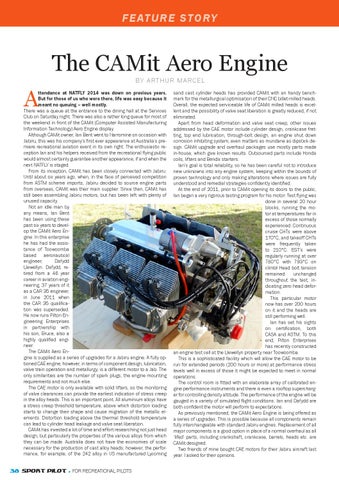FEATURE STORY
The CAMit Aero Engine BY ARTHUR MARC EL
A
ttendance at NATFLY 2014 was down on previous years. But for those of us who were there, life was easy because it meant no queuing – well mostly. There was a queue at the entrance to the dining hall at the Services Club on Saturday night. There was also a rather long queue for most of the weekend in front of the CAMit (Computer Assisted Manufacturing Information Technology) Aero Engine display. Although CAMit owner, Ian Bent went to Narromine on occasion with Jabiru, this was his company’s first ever appearance at Australia’s premiere recreational aviation event in its own right. The enthusiastic reception Ian and his helpers received from the recreational flying public would almost certainly guarantee another appearance, if and when the next NATFLY is staged. From its inception, CAMit has been closely connected with Jabiru. Until about six years ago, when, in the face of perceived competition from ASTM scheme imports, Jabiru decided to source engine parts from overseas, CAMit was their main supplier. Since then, CAMit has still been assembling Jabiru motors, but has been left with plenty of unused capacity. Not an idle man by any means, Ian Bent has been using these past six years to develop the CAMit Aero Engine. In this enterprise he has had the assistance of Toowoomba based aeronautical engineer, Dafydd Llewellyn. Dafydd, retired from a 46 year career in aviation engineering, 37 years of it as a CAR 35 engineer, in June 2011 when the CAR 35 qualification was superseded. He now runs Pilton Engineering Enterprises in partnership with his son, Bruce, also a highly qualified engineer. The CAMit Aero Engine is supplied as a series of upgrades for a Jabiru engine. A fully optioned CAE engine, however, in terms of component design, lubrication, valve train operation and metallurgy, is a different motor to a Jab. The only similarities are the number of spark plugs, the engine mounting requirements and not much else. The CAE motor is only available with solid lifters, so the monitoring of valve clearances can provide the earliest indication of stress creep in the alloy heads. This is an important point. All aluminium alloys have a stress creep threshold temperature, above which distortion loading starts to change their shape and cause migration of the metallic elements. Distortion loading above the thermal threshold temperature can lead to cylinder head leakage and valve seat liberation. CAMit has invested a lot of time and effort researching not just head design, but particularly the properties of the various alloys from which they can be made. Australia does not have the economies of scale necessary for the production of cast alloy heads; however, the performance, for example, of the 242 alloy in US manufactured Lycoming 38 Sport Pilot .
FOR RECREATIONAL PILOTS
sand cast cylinder heads has provided CAMit with an handy benchmark for the metallurgical optimisation of their CNC billet-milled heads. Overall, the expected serviceable life of CAMit milled heads is excellent and the possibility of valve seat liberation is greatly reduced, if not eliminated. Apart from head deformation and valve seat creep, other issues addressed by the CAE motor include cylinder design, crankcase fretting, top end lubrication, through-bolt design, an engine shut down corrosion inhibiting system, even matters as mundane as dipstick design. CAMit upgrade and overhaul packages use mostly parts made in-house, which give known results. Outsourced parts include Honda coils, lifters and Bendix starters. Ian’s goal is total reliability, so he has been careful not to introduce new unknowns into any engine system, keeping within the bounds of proven technology and only making alterations where issues are fully understood and remedial strategies confidently identified. At the end of 2011, prior to CAMit opening its doors to the public, Ian began a very rigorous testing program for his motor. Test flying was done in several 20 hour blocks, running the motor at temperatures far in excess of those normally experienced. Continuous cruise CHTs were above 170°C, and takeoff CHTs were frequently taken to 210°C. EGT’s were regularly running at over 780°C with 793°C on climb! Head bolt tension remained unchanged throughout the test, indicating zero head deformation. This particular motor now has over 200 hours on it and the heads are still performing well. Ian has set his sights on certification, both CASA and ASTM. To this end, Pilton Enterprises has recently constructed an engine test cell at the Llewellyn property near Toowoomba. This is a sophisticated facility which will allow the CAE motor to be run for extended periods (200 hours or more) at performance stress levels well in excess of those it might be expected to meet in normal operations. The control room is fitted with an elaborate array of calibrated engine performance instruments and there is even a rooftop supercharger for controlling density altitude. The performance of the engine will be gauged in a variety of simulated flight conditions. Ian and Dafydd are both confident the motor will perform to expectations. As previously mentioned, the CAMit Aero Engine is being offered as a series of upgrades. This is possible because all components remain fully interchangeable with standard Jabiru engines. Replacement of all major components is a good option in place of a normal overhaul as all ‘lifed’ parts, including crankshaft, crankcase, barrels, heads etc. are CAMit designed. Two friends of mine bought CAE motors for their Jabiru aircraft last year. I asked for their opinions.
